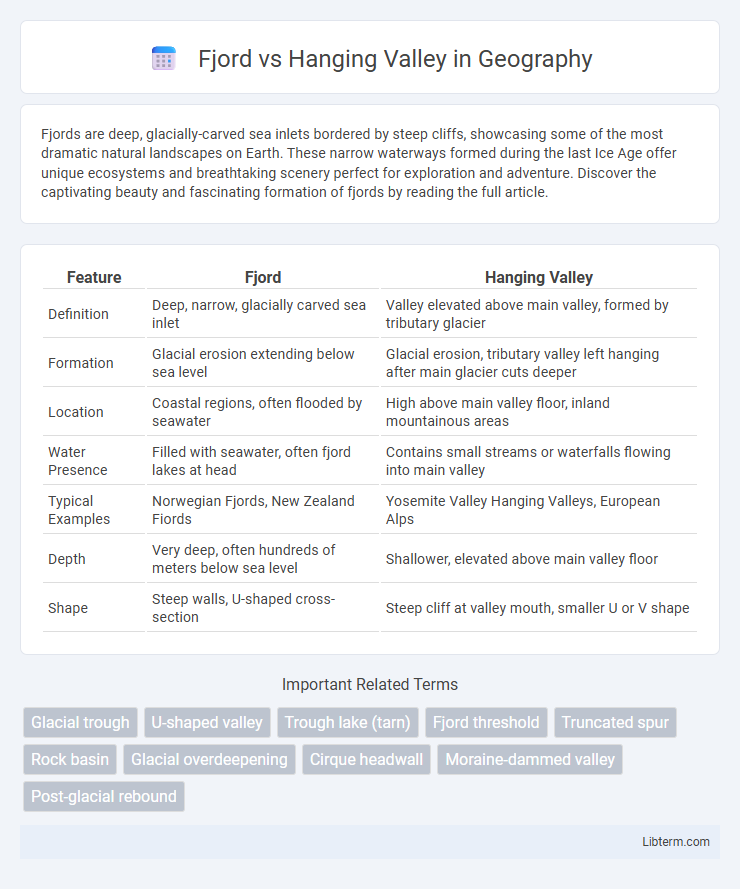Fjords are deep, glacially-carved sea inlets bordered by steep cliffs, showcasing some of the most dramatic natural landscapes on Earth. These narrow waterways formed during the last Ice Age offer unique ecosystems and breathtaking scenery perfect for exploration and adventure. Discover the captivating beauty and fascinating formation of fjords by reading the full article.
Table of Comparison
| Feature | Fjord | Hanging Valley |
|---|---|---|
| Definition | Deep, narrow, glacially carved sea inlet | Valley elevated above main valley, formed by tributary glacier |
| Formation | Glacial erosion extending below sea level | Glacial erosion, tributary valley left hanging after main glacier cuts deeper |
| Location | Coastal regions, often flooded by seawater | High above main valley floor, inland mountainous areas |
| Water Presence | Filled with seawater, often fjord lakes at head | Contains small streams or waterfalls flowing into main valley |
| Typical Examples | Norwegian Fjords, New Zealand Fiords | Yosemite Valley Hanging Valleys, European Alps |
| Depth | Very deep, often hundreds of meters below sea level | Shallower, elevated above main valley floor |
| Shape | Steep walls, U-shaped cross-section | Steep cliff at valley mouth, smaller U or V shape |
Introduction to Fjords and Hanging Valleys
Fjords are deep, glacially carved inlets with steep cliffs, formed by the submergence of U-shaped valleys after glacier retreat. Hanging valleys are elevated valleys created by tributary glaciers that join a main glacier, resulting in waterfalls or steep drops where the smaller valley meets the deeper main valley. Both landforms provide key insights into glacial erosion processes and landscape evolution.
Geological Formation: Fjord vs Hanging Valley
Fjords are deep, glacially carved valleys submerged by rising sea levels, characterized by steep cliffs and extensive underwater troughs formed through prolonged glacial erosion. Hanging valleys occur where smaller tributary glaciers meet a main glacier, resulting in elevated valleys that abruptly drop into the main valley, often creating waterfalls. The primary geological distinction lies in fjords being submerged U-shaped valleys connected to the sea, whereas hanging valleys remain elevated landforms above the main glacial valley floor.
Key Characteristics of Fjords
Fjords are deep, narrow inlets of the sea between high cliffs or steep slopes, formed by glacial erosion and characterized by their U-shaped valleys and significant depth extending below sea level. They exhibit a saltwater basin often connected to the ocean, with steep rock walls shaped by ice movement and typically possess fjord heads that may include waterfalls or rivers. In contrast, hanging valleys are elevated glacial valleys that end abruptly above the main valley floor, often marked by waterfalls but not extending into deep marine environments like fjords.
Distinctive Features of Hanging Valleys
Hanging valleys are characterized by their elevated position above a main valley, often marked by steep cliffs or waterfalls where they join larger glacial valleys. These landforms result from differential glacial erosion, where tributary glaciers carve shallower valleys compared to the deeper main glacier troughs, leading to a noticeable elevation difference. Unlike fjords, which are deep, water-filled glacial valleys connected to the sea, hanging valleys frequently remain dry or contain small streams and are distinct for their abrupt, elevated junctions to main valleys.
Similarities Between Fjords and Hanging Valleys
Fjords and hanging valleys both originate from glacial activity, showcasing steep, U-shaped valleys carved by glacier movement. Each features dramatic cliffs and troughs formed through similar erosional processes, highlighting the power of ice in shaping terrain. These landscapes also often contain bodies of water, fjords filled by seawater and hanging valleys sometimes hosting waterfalls or streams descending into a main valley.
Differences in Landscape and Topography
Fjords are deep, glacially carved sea inlets characterized by steep cliffs and U-shaped valleys filled with seawater, often formed by the submergence of glaciated valleys. Hanging valleys are elevated valleys carved by tributary glaciers, typically found above a main valley, featuring abrupt drops or waterfalls where they meet lower valleys. The key difference lies in their topography: fjords exhibit deep, water-filled trenches with steep sides, while hanging valleys are perched higher, creating distinct vertical relief above the main glacial trough.
Examples of Famous Fjords Around the World
Fjords, such as Norway's Sognefjord and New Zealand's Milford Sound, are deep, glacially carved inlets characterized by steep cliffs and narrow waterways, contrasting with hanging valleys which are elevated valleys formed by tributary glaciers. Iconic fjords like Geirangerfjord in Norway and Alaska's Glacier Bay showcase dramatic vertical drops and vibrant ecosystems shaped by glacial activity. These fjords serve as prime examples of glacial erosion and deposition, highlighting their distinct geological features compared to the typically shallower and flatter hanging valleys.
Notable Hanging Valleys: Global Locations
Notable hanging valleys can be found in iconic locations such as the Yosemite Valley in California, where Bridalveil Fall cascades from a hanging valley into the main valley. The Norwegian fjords, including Geirangerfjord and Sognefjord, also feature prominent hanging valleys formed by glacial erosion. In New Zealand, the Southern Alps showcase dramatic hanging valleys that contribute to the region's striking alpine and fjord landscapes.
Ecological Importance and Biodiversity
Fjords and hanging valleys each support unique ecosystems crucial for biodiversity conservation. Fjords, formed by glacial carving and filled with seawater, create nutrient-rich habitats that sustain diverse marine life, including fish, invertebrates, and algae. Hanging valleys, elevated above main valleys, often host specific microclimates and freshwater ecosystems vital for endemic plant species and terrestrial wildlife, contributing to overall ecological resilience.
Tourism and Recreational Activities in Fjords and Hanging Valleys
Fjords, characterized by deep, glacially carved waterways surrounded by towering cliffs, attract tourists for activities such as kayaking, boat tours, and wildlife watching, especially marine life like seals and orcas. Hanging valleys, perched above main valleys, offer unique hiking and rock climbing opportunities with stunning viewpoints ideal for photography and nature observation. Both landscapes provide different recreational experiences, with fjords emphasizing water-based exploration and hanging valleys favoring elevated hiking trails and scenic vistas.
Fjord Infographic

 libterm.com
libterm.com